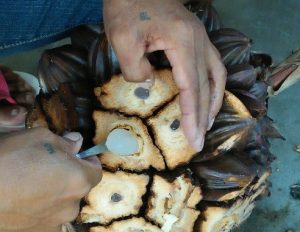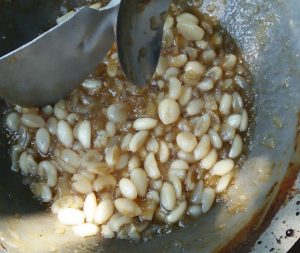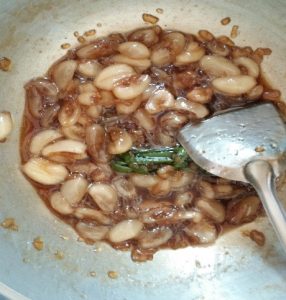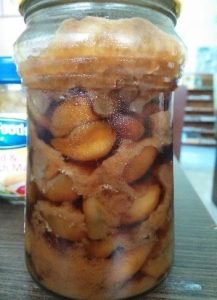
By RFO5 Correspondent, Sandy Bobbier
Pamplona, Camarines Sur. The Department of Agriculture Regional Field Office 5 thru the Adaptation and Mitigation Initiative in Agriculture (AMIA) has conducted product development for nipa fruit in the AMIA Village, Brgy. Cagbunga. Pamplona, Camarines Sur last October 9, 2018. The AMIA Village lies along the Bicol River Basin.
Nipa grows mainly along the coastlines and estuarine habitats. Carpels of nipa fruits are numerous, dark-brown, striate, smooth, 10 to 14 centimeters long, compressed, obovate. The immature fruit has soft flesh; it can be used as fresh fruit. Seeds are hard, white, and as large as a hen’s egg in central of a nut. (www.worldwidefruits.com).





Nipa fruit extraction. In extracting the soft flesh, the fruits can be halved, or its bottom part is cut to expose the flesh and carefully extracting it to produce whole flesh. Each ball (cluster of fruits) can generate up to 43 soft flesh nipa fruit.
Nipa, the only palm considered as mangrove, has been used mainly for roofing. Nipa fruit has been long ignored by the locals as there is currently no available standard in its processing. In the test conducted of AMIA Team, a mean of 433 grams of soft flesh can be extracted per fruit. Each fruit can have up to 43 edible flesh. Extraction is still for improvement as one-third of the flesh were considered broken. A report from DENR (www. r3.denr.gov.ph) revealed that sap of nipa fruits is collected once a year using a bamboo tube attached to a healthy stalk of mature nipa fruits. Thus, after removing the fruit, the farmers can still extract sap which can then be processed into wine, vinegar, salt or sugar.
In processing the nipa fruit, matured balls are collected. Its ripe fruits are collected, broken into two while carefully extracting the fruit. The white soft flesh is then placed into a bowl for cleaning. The flesh can be processed into jam, candy and as substitute for potato in empanada. As for the locals, the potential of nipa is endless.



From Raw to Processed Nipa Fruit! While largely ignored by locals due to tedious extraction process and lack of processing standards, nipa fruit is processed into a delicious nipa fruit sweet! Teaming up with the DA RFO 5 Food Laboratory, further product development will be conducted.
How to make preserved Nipa Fruit Sweet
Ingredients:
1 cup nipa whole fruit
1 cup brown/white sugar
1 teaspoon vanilla
Materials:
Pan
Long-handle spoon
Stove
Instruction:
- Heat the pan over low fire in the stove.
- Once already hot, place the cup of nipa fruit in the pan. Stir until tender.
- Put and mix 1 cup brown or white sugar into the pan. Still until preffered thichness desired reached.
- Add vanilla to flavor.
- Cool the nipa fruit sweet and store in the preserving jar.
